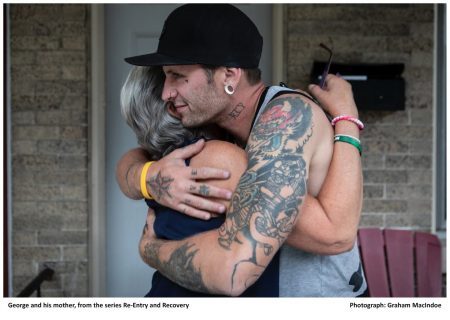Beyond addiction: reframing recovery
|
New York, April 4, 2019 -- There are about 23 million people in the United States who have successfully resolved a problem with drugs or alcohol, but we rarely see or hear their stories, especially compared to depictions of addiction in media, art, music, and film. Although not everyone identifies as being “in recovery” and many people can’t publicly acknowledge their past because of stigma or the consequences of admitting illegal drug use, a growing movement is working to offer examples of success and hope to those still struggling with addiction. Featuring work by 13 artists as well as students at The New School, Beyond Addiction: Reframing Recovery is a two-week exhibition that will not only show that recovery is possible, but also will highlight some of the ways people have rebuilt their lives after a period of problematic drug or alcohol use. Through photographs, text, audio, and artwork, the projects depict a range of experiences with recovery and the treatment providers and harm reduction services that many people rely on, often at times when they feel isolated and overwhelmed The show is curated by Graham MacIndoe, a photographer and assistant professor at Parsons School of Design, and Susan Stellin, a reporter and adjunct professor in the Journalism + Design department at The New School who recently completed a master’s in public health at Columbia University. They have collaborated on past projects combining interviews and photography, including exhibitions, talks, and Chancers, a memoir documenting MacIndoe's addiction, incarceration, and recovery. Many of the artists in the exhibition have personal experience with addiction and recovery or worked closely with the individuals whose stories they documented through long-term collaborations. “We’ve seen so many photographs and stories about addiction and overdose deaths, but rarely talk about what comes after you decide to quit using alcohol or drugs,” MacIndoe said. “Susan and I started documenting the stories of people we knew who had gone through that process, then decided to find other artists working on projects related to recovery and the different pathways people take to get there.” "In the context of the current opioid epidemic, Beyond Addiction has enormous cultural urgency and makes an important contribution to the discussion by shifting focus from addiction to recovery and harm reduction," said Christiane Paul, director and chief curator of the Sheila C. Johnson Design Center at The New School's Parsons School of Design. "The images brought together in this exhibition are grounded in a deep personal involvement with the complexities of recovery. They provide a view from the inside that opens possibilities for more nuanced discussion and engagement within The New School community." In addition to the 13 artists, the show will present several student projects, supervised by MacIndoe and Julia Gorton, assistant professor of communications at Parsons. Featured Artists and Work: Graham MacIndoe and Susan Stellin: Re-Entry & Recovery Portraits and interviews with people navigating life after addiction and incarceration, from a larger series documenting stories of recovery. Nina Berman: An autobiography of Miss Wish A multi-dimensional collaborative work focusing on the story of one woman and the intersection of sexual trauma, mental illness, addiction, and recovery. Allan Clear: Lower East Side Needle Exchange Photos of people, events, activism, and art from this community center at the height of the HIV/AIDS epidemic in the early 1990s. Tony Fouhse: Live Through This Photos of a young woman Fouhse met who asked for help getting into a rehab program, which enabled her to escape life on the street. Neil Sneddon Developing Recovery Photos taken by clients Sneddon asked to document the people, places, and things they identified as meaningful for their recovery. Paul Gorman: Rip and Run Spoken word pieces and images commenting on Gorman's past drug use and his life now in recovery. Luceo: Harm Reductionists Photos of supporters of the harm reduction movement paired with handwritten responses to question prompts. Yannick Fornacciari: Heroin Days Images and text juxtaposing Fornacciari's first day on methadone with how he felt after a year of treatment. Jackie Neale: Common Ground Tacony A cyanotype portrait banner of Richard, who tends to a garden in the Tacony neighborhood of North Philadelphia as part of his recovery from addiction. John Donadeo: Family Ties Portraits of Donadeo's extended family and friends exploring the socioeconomic and familial factors that impact addiction and recovery. John H. Linder Jr: Art Therapy Artwork Linder created in a program that helps participants use art as part of a therapeutic process to address drug and alcohol problems. Graham MacIndoe: Thank You for Sharing Instagram and Facebook posts reflecting on MacIndoe's addiction, incarceration, and recovery, which have inspired others to share their experiences as well. Josh Meltzer: Dopesick—Agents of Change Portraits of treatment providers, healthcare workers, activists, and counselors shot for Dopesick: Dealers, Doctors, and the Drug Company that Addicted America, by Beth Macy. Student Projects: Lucy Xin and Josie Stevenson: Responding to Recovery An interactive experience inviting visitors to respond to open-ended questions about what recovery means to them by writing their thoughts on wall panels and postcards. Carly Bayroff and Scoutt Palframan: Not Just a Label An animated projection that replaces derogatory terms associated with people who use drugs with positive identities, to show that no one should be defined by negative labels. Ellie Plass: Harm Reduction at The New School An interview addressing student substance use, addiction, harm reduction services, and rehabilitation based on insight from those who have direct experience with this issue. Sara Akiki: Recovery in Perspective A project that uses stenciling to reframe our notion of recovery by allowing viewers to re-evaluate the world from a different perspective. The exhibition opens on Saturday, April 6th and runs through April 20th at the Arnold and Sheila C. Johnson Design Center. There will be an opening reception on Tuesday, April 9th between 5:30 and 6:30 p.m. in the gallery followed by a panel discussion between 6:30 PM and 8 PM at the Anna-Maria and Stephen Kellen Auditorium at 66 5th Avenue, ground floor. The topic of the discussion will be Art, Media, Research, and Advocacy: What Shapes Public Opinion and Drug Policy? Moderated by Susan Stellin, the panel features Graham MacIndoe, Tracie Gardner, vice president of policy advocacy for the Legal Action Center, and Pedro Mateu-Gelabert, principal investigator and deputy director, Institute of Infectious Disease Research at the National Development Research Institutes, Inc. The program is part of the Open Society Foundations Dialogues on Drug Policy series at The New School.
|
|
Founded in 1919, The New School was established to advance academic freedom, tolerance, and experimentation. A century later, The New School remains at the forefront of innovation in higher education, inspiring more than 10,000 undergraduate and graduate students to challenge the status quo in design and the social sciences, liberal arts, management, the arts, and media. The university welcomes thousands of adult learners annually for continuing education courses and public programs that encourage open discourse and social engagement. Through our online learning portals, research institutes, and international partnerships, The New School maintains a global presence.
|
 |
MARKETING AND COMMUNICATION |
| 79 Fifth Avenue New York, NY 10003 www.newschool.edu |
PRESS RELEASE |
Media Contact: The New School |
|
|
